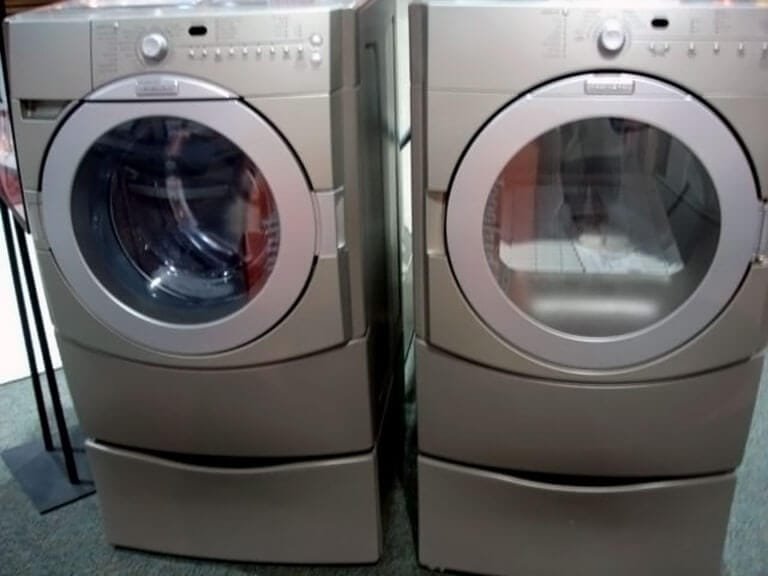When your trusty Kitchenaid washer suddenly stops spinning, it’s more than just a hiccup in your laundry routine—it’s a full-blown inconvenience. You rely on your washer to keep your clothes fresh and clean, and when it doesn’t perform, you feel stuck.
Maybe you’ve noticed your clothes are coming out wetter than usual, or perhaps there’s a strange noise coming from the machine. Whatever the case, you’re likely frustrated and ready to find a solution. You’re not alone in this struggle. Many Kitchenaid washer owners experience similar issues, and the good news is that there are straightforward fixes you can try before calling a professional.
In this guide, we’ll walk you through common causes and practical solutions to get your washer spinning again. You’ll gain the knowledge you need to tackle the problem head-on and get back to your routine with minimal hassle. So, let’s dive in and uncover how you can solve this spinning dilemma with ease.
Common Causes
When your KitchenAid washer refuses to spin, it can feel like your laundry routine has hit a roadblock. Understanding the common causes of this issue can help you troubleshoot effectively and get your machine back in action. Let’s dive into the most frequent culprits that could be preventing your washer from spinning properly.
Motor Issues
The motor is the heart of your washer, responsible for the spinning motion. If your washer’s motor is faulty, it can lead to a complete stop in the spinning cycle. You might notice unusual noises or a complete silence when it should be spinning. Replacing or repairing the motor can often solve the problem. Have you ever experienced a washer that hums but doesn’t move? It’s likely a motor issue.
Belt Problems
The belt connects the motor to the drum and ensures efficient spinning. If this belt wears out or breaks, the drum won’t spin. You might find your laundry soaking wet, even after a complete cycle. Checking the belt for wear and replacing it if necessary can restore your washer’s functionality. Imagine the belt as the link between power and performance—without it, spinning is impossible.
Lid Switch Malfunction
The lid switch prevents the washer from spinning if the lid is open. A malfunctioning switch can trick your washer into thinking the lid is open, halting the spin cycle. This issue can often be resolved by replacing the switch. Have you ever tried restarting your washer only to find it still refuses to spin? The lid switch could be the culprit.
Pump Blockage
A blockage in the pump can cause water to remain in the drum, stopping the spin cycle. This can happen if debris or lint clogs the pump. Clearing the blockage can help your washer spin again and drain properly. Think of the pump as the washer’s drainage system—clogs here can lead to a standstill.
Have you ever tackled any of these issues yourself? Fixing these common problems can save you time and money. Understanding your machine better allows you to address problems efficiently. So next time your washer refuses to spin, you’ll know where to start looking.
Initial Checks
Is your Kitchenaid washer refusing to spin? Before calling for repair, there are simple checks to do. These steps can save time and money.
Power Supply
First, check the power supply. Ensure the washer is plugged in properly. A loose plug can stop the machine from spinning. Check the outlet for power. Try another device to confirm electricity flows.
Door Closure
Next, inspect the door. Is it closed tightly? A washer will not spin if the door is ajar. Listen for a click when closing. This sound means the door is secure.
Load Balance
Lastly, assess the load balance. Overloading can prevent spinning. The washer may struggle with heavy, uneven loads. Redistribute items for a balanced spin.
Diagnostic Tools
Have you ever stood in front of your Kitchenaid washer, expecting the spin cycle to kick in, only to be met with silence? This common frustration can turn laundry day into a puzzle. Understanding diagnostic tools is crucial to solving this mystery. With the right tools, you can pinpoint the issue and get your washer spinning again.
Multimeter Use
A multimeter is a handy tool that can help you test electrical components in your washer. By checking the continuity of wires and measuring voltage, you can identify potential electrical problems.
Imagine using the multimeter to test the washer’s motor. A reading outside the normal range could indicate a malfunction, helping you focus your efforts where they’re needed most. It’s straightforward and efficient.
Error Codes Interpretation
Modern washers often communicate their troubles through error codes. These codes can seem cryptic at first glance, but they hold vital clues to what’s going wrong.
Have you ever seen an error code flash on your washer’s display? These codes can guide you in identifying specific faults, like a blocked pump or a faulty lid switch. Understanding these codes is like having a direct line to your washer’s thoughts.
In your experience, have you noticed how sometimes a simple reset can clear these codes? It’s an insight worth exploring further. What does your washer say when it speaks in error codes?
By using diagnostic tools like a multimeter and understanding error codes, you can tackle the problem head-on. Wouldn’t it be great to solve the spinning issue yourself and get back to your laundry without the hassle? Try these tools and see how they transform your approach to washer woes.
Kitchenaid Washer Not Spinning [Here is the Diy Solutions]

If your Kitchenaid washer isn’t spinning, don’t worry. You can try some DIY solutions before calling a professional. These solutions can help you fix common spinning issues. They are easy to follow and require only basic tools. Let’s dive into some effective DIY methods.
Resetting The Washer
Resetting the washer can solve many minor issues. To reset, unplug your washer from the power source. Wait for about one minute. This allows the washer to reset its systems. Plug it back in and try running a spin cycle. This simple step can often restore normal function.
Replacing The Lid Switch
If your washer still doesn’t spin, check the lid switch. A faulty lid switch can prevent spinning. First, unplug the washer for safety. Locate the lid switch near the door frame. Use a screwdriver to remove it. Replace it with a new one. Ensure the new switch is securely in place. Plug the washer back in and test it. A working lid switch can fix spinning issues.
Cleaning The Pump
A clogged pump can also stop your washer from spinning. To clean the pump, first unplug the washer. Locate the pump at the bottom of the washer. Remove any visible debris or blockages. Use a flashlight to check inside the pump. Clear any remaining clogs. Reassemble the pump carefully. Plug the washer back in and test the spin cycle. A clean pump helps maintain proper function.
Professional Help
Struggling with a KitchenAid washer that won’t spin? Professional help can diagnose and fix mechanical issues quickly. Ensure your appliance runs smoothly with expert service.
When your KitchenAid washer stops spinning, it’s more than just a minor inconvenience. You rely on it to keep your clothes fresh and your household running smoothly. While some issues can be easily resolved with a quick fix, others require the expertise of a professional technician. Understanding when it’s time to call in the experts can save you time, money, and frustration.
When To Call A Technician
Sometimes, no amount of DIY troubleshooting will get your washer spinning again. If you’ve checked for common problems like unbalanced loads or clogged hoses and the issue persists, it’s time to consider professional help. A technician has the tools and knowledge to diagnose complex issues like motor malfunctions or electronic control board failures. Don’t wait until the problem worsens—early intervention can prevent further damage. Another signal to call a technician is strange noises during the spin cycle. Grinding or banging sounds can indicate a serious internal problem. Attempting to fix these without proper expertise might lead to more harm than good. Trusting a professional ensures the job is done right the first time.
Cost Considerations
Thinking about the cost of hiring a technician might make you hesitate. However, ignoring a problem can lead to more expensive repairs down the line. Professional repairs can extend the lifespan of your washer, ultimately saving you money. Understanding what factors into the cost can help you budget appropriately. Fees typically include labor and parts, and some companies might charge a service call fee. It’s wise to get a quote before work begins to avoid surprises. Consider the potential cost of a new washer if repairs are delayed or done incorrectly. Investing in a professional repair might be the more economical choice. Have you had an experience where a quick fix turned into a costly mistake? Share your story in the comments and help others make informed decisions.
Preventive Measures
Regular cleaning of the filter and checking for any blockages can prevent spinning issues in your Kitchenaid washer. Ensuring the washer is not overloaded helps maintain its optimal performance. Periodic inspection of belts and motor connections can avert potential problems.
Preventive measures can save you from the frustration of a Kitchenaid washer that refuses to spin. Taking simple steps to maintain your washer can extend its life and keep it running smoothly. Below are some practical tips to help you avoid spinning issues with your washer.
Regular Maintenance
Maintaining your washer regularly ensures it remains in good working condition. Check the drum and door seals for any debris or buildup. Cleaning these areas can prevent blockages that may affect the spinning function. Inspect the hoses for any cracks or leaks. Replacing worn-out hoses can prevent water from seeping into unwanted areas. Regularly checking the filter is also crucial, as a clogged filter can hinder the spin cycle.
Proper Loading Techniques
Proper loading can make a significant difference in your washer’s performance. Overloading the washer can lead to imbalance, causing it to stop spinning correctly. Always follow the manufacturer’s guidelines for load capacity. Distribute clothes evenly around the drum. Uneven loads can cause the washer to vibrate excessively, which might disrupt the spinning process. Consider washing large and heavy items separately to maintain balance. Have you ever tried loading your washer with too many towels, only to find it struggling to spin? Avoid this common mistake to keep your washer functioning at its best. Incorporating these preventive measures into your laundry routine can keep your Kitchenaid washer spinning without a hitch. What small change can you make today to enhance your washer’s performance?
Frequently Asked Questions
Why Is My Kitchenaid Washer Not Spinning?
A broken belt or motor issue might be causing this problem. Check these parts for wear or damage.
How Can I Fix A Washer That Won’t Spin?
Inspect the drive belt and motor. Replace damaged parts. Ensure the washer is level and balanced.
Is A Faulty Lid Switch Causing Spin Issues?
Yes, a faulty lid switch can prevent spinning. Check and replace the switch if it’s defective.
Could Overloading Affect My Washer’s Spin Cycle?
Yes, overloading can prevent spinning. Remove excess clothes and try again. Balance the load for best results.
What Should I Do If The Drain Pump Is Blocked?
Clear any blockages in the drain pump. Remove debris or foreign objects. Ensure proper water flow.
Conclusion
Fixing a Kitchenaid washer not spinning can seem tricky. But, with patience and the right steps, it’s manageable. Check basic things first like load balance and door latch. Ensure the power supply is steady. Consider examining the motor and belt for issues.
Regular maintenance helps avoid future problems. If unsure, contacting a professional is wise. Keep these tips in mind for a smooth laundry day. A working washer means clean clothes and peace of mind. Remember, understanding your appliance better leads to fewer hassles.
Happy washing!
